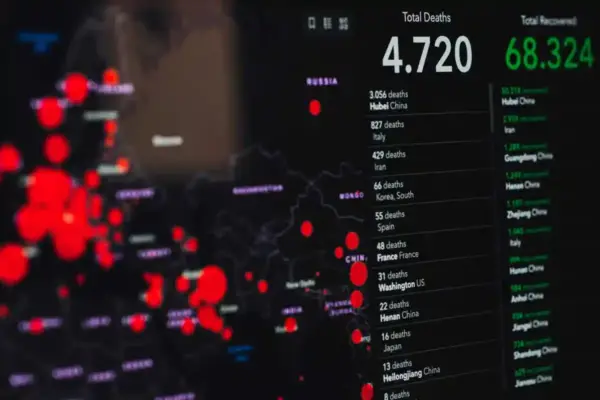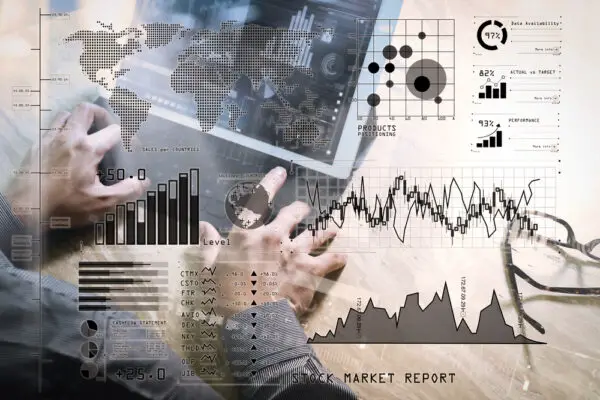Key Risk Indicators (KRIs) serve as an early warning system, allowing businesses to detect changes in risk exposure before these risks can significantly impact the organization. Some ways in which KRIs help in identifying emerging risks:
Early Warning System: Key risk indicators are designed to signal changes in risk exposure, providing an early warning of potential issues. For example, if a company’s KRI for customer complaints rises, it could indicate an emerging product quality risk or customer service risk.
Trend Analysis: By tracking Key risk indicators over time, companies can identify trends and patterns that might indicate an emerging risk. For instance, a steady increase in employee turnover might signal an emerging risk related to employee morale or job satisfaction.
Benchmarking: KRIs allow companies to benchmark their performance against industry standards or competitors. If a company’s Key risk indicator significantly differs from the industry average, it could indicate an emerging risk that must be addressed.
Risk Prioritization: KRIs help companies prioritize their risk management efforts. By focusing on the areas with the highest Key risk indicator, companies can allocate their resources more effectively and address the most significant risks first.
Proactive Decision Making: By providing real-time data on risk exposure, Key risk indicators enable companies to make proactive decisions. Instead of reacting to crises as they occur, companies can use KRIs to anticipate risks and implement preventive measures.
Risk Culture: Using Key risk indicators can help foster a risk-aware culture within the organization. When employees at all levels know the KRIs relevant to their work, they are more likely to identify and report potential risks.
KRIs are specific metrics that provide insight into the likelihood of an adverse event occurring and its potential impact. They help organizations effectively monitor their exposure to different types of risks, including operational, financial, strategic, and reputational risks.
Key risk indicators can be customized to suit a company’s unique risk profile and used across various departments to track performance against predetermined thresholds.

Understanding the Concept of Key Risk Indicators
Key Risk Indicators (KRIs) are a widely recognized framework that enables companies to identify and monitor potential risks by providing an objective and measurable approach.
Key risk indicators are metrics used to measure the likelihood or impact of a risk event occurring within an organization.
These indicators help organizations to manage their risks rather than reacting after the fact proactively.
It is important to note that Key risk indicator differ from Key Performance Indicators (KPIs).
While KPIs focus on measuring performance against predetermined goals, KRIs focus on identifying potential risks that could negatively impact an organization’s objectives.
KRIs provide early warning signals for emerging risks, allowing organizations to take corrective action before the risk becomes a major issue.
Key risk indicators can be applied across various organizational industries and functions.
For example, in finance, Key risk indicators may include measures such as liquidity ratios or credit default rates.
In information technology, KRIs may include measures such as system downtime or cybersecurity incidents.
Identifying Emerging Risks
Identifying emerging risks involves a systematic approach to uncovering potential risks before they become significant.
Techniques for identifying emerging risks include:
- Environmental scanning.
- Trend analysis.
- Scenario planning.
- Risk workshops.
Why Identifying Emerging Risks is Important
Recognizing the significance of identifying emerging risks is essential for companies’ long-term success and sustainability. This is because, without identifying these risks in advance, companies may not implement appropriate mitigation strategies to address them if they occur.
Emerging risks are currently unknown or not yet fully understood but have the potential to impact a company’s operations or reputation significantly.
For example, technological advancements such as artificial intelligence and blockchain technology could present both opportunities and challenges for businesses in various industries.
Moreover, with the increasing pace of change in the business environment due to globalization, political instability, climate change, and other factors, it has become even more critical for organizations to identify emerging risks promptly.
Early identification allows companies to be proactive rather than reactive when managing risk. By doing so, they can stay ahead of competitors who may not be as prepared for future disruptions or crises.
Techniques for Identifying Emerging Risks
Effective risk management requires various strategies to avoid potential disruptions and emerging threats in the business environment. Risk mapping and trend analysis are two key techniques companies use for identifying emerging risks.
Risk mapping involves analyzing a company’s operations, processes, products, and services to identify areas where risks may arise. This technique allows companies to visualize and prioritize risks based on their impact on the organization.
A risk map can be developed by plotting identified risks along two axes: likelihood of occurrence and severity of impact. This enables organizations to focus their resources on managing those risks that pose the greatest threat to their operations.
Trend analysis involves tracking changes in internal and external factors affecting a company’s operations over time.
Organizations can anticipate potential disruptions before they occur by monitoring trends in areas such as technological developments, regulatory changes, consumer behavior, economic indicators, and social trends.
Trend analysis provides a forward-looking perspective on emerging risks that may not yet be evident but could significantly impact an organization.

The Role of KRIs in Identifying Emerging Risks
Using key risk indicators (KRIs) is crucial in detecting potential emerging risks within a company’s operations.
Key risk indicator implementation involves identifying and analyzing relevant data to monitor the performance of a business, assess potential risks, and develop mitigation strategies for any identified threats.
Key risk indicators can assist companies in identifying emerging risks by providing an objective performance measure against predetermined thresholds or benchmarks. By tracking these indicators over time, organizations can identify trends or patterns that may indicate the onset of a new risk.
Kris also helps management prioritize resources toward activities that mitigate these emerging risks, ensuring that limited resources are used effectively in managing potential threats.
Furthermore, Key risk indicators allow companies to assess their internal controls and make necessary improvements based on areas highlighted as high-risk through KRI monitoring.
This approach enables businesses to be more agile in their risk management processes since they can quickly adapt to changes in the internal or external environment if they have an effective key risk indicator program in place.
Incorporating KRIs into an organization’s risk management framework can improve its overall resilience by enabling it to detect emerging risks early, respond promptly, and reduce negative impacts on its operations.
Implementing KRIs in Your Organization
To implement KRIs effectively, ensuring effective communication within the organization is crucial. This involves sharing information about potential risks and ensuring everyone understands their role in mitigating them.
When employees are aware of the potential hazards and are equipped with the necessary tools and resources to address them, they can take proactive measures to prevent or minimize risk.
Employee engagement is another critical factor in implementing effective KRIs. Engaged employees are more likely to be proactive in identifying emerging risks and taking action to mitigate them.
Conversely, disengaged employees may overlook or ignore potential hazards, putting the company at risk. Therefore, creating a culture where employees feel valued and empowered to speak up when they observe something that could threaten the organization is essential.
To summarize, implementing effective KRIs requires effective communication and employee engagement within the organization.
- Regular training sessions on KRI identification techniques.
- Encourage open communication channels across all levels of staff.
- Create incentives for employees who proactively identify new emerging risks within their departments.
Monitoring and Evaluating KRIs
Tracking trends and analyzing data can provide valuable insights into potential threats that could emerge in the future.
Companies need to establish a framework for monitoring KRIs, including regular reviews, analysis, and reporting. This will help them identify emerging risks early on, allowing them to take proactive measures to minimize their impact.
One critical aspect of monitoring KRIs is tracking trends over time. By doing so, companies can identify patterns or anomalies that may indicate new or evolving risks.
For example, a sudden increase in cyber attacks targeting a particular type of software used by the company could indicate an emerging threat that needs immediate attention. Monitoring such metrics allows organizations to detect these threats before they escalate into more significant problems.
Another crucial element of evaluating KRIs involves analyzing data for potential risks. Companies need to leverage technology tools like machine learning algorithms and predictive analytics models to analyze large datasets quickly and accurately.
This enables them to identify correlations between variables and uncover hidden patterns or relationships that may indicate emerging risks. Using advanced analytical techniques, companies can better understand their risk landscape and make informed decisions about how best to mitigate those risks.
Monitoring and evaluating KRIs are fundamental processes for organizations looking to stay ahead of potential threats in today’s dynamic business environment. As such, it is essential for firms to have robust frameworks in place for KRI monitoring that include regular reviews, analysis, and reporting mechanisms.
Frequently Asked Questions
What are some common challenges companies face when implementing KRIs?
Common challenges in implementing KRIs include inadequate employee training on data analysis, lack of standardized KRI definitions, and difficulty integrating KRIs into existing risk management processes.
How can companies ensure that their KRIs are accurate and reliable?
Accurate and reliable KRI requires proper data validation and monitoring techniques. Companies can achieve this by utilizing advanced analytical tools, ensuring the consistency of data sources, and conducting regular reviews to identify any necessary adjustments or updates.
Can KRIs be used to identify both internal and external risks?
Internal and external KRIs can identify risks across all industries. Internal KRIs focus on operational and financial risks, while external KRIs assess market and environmental risks. The applicability of KRIs depends on the industry and the company’s unique risk profile.
What is the role of technology in KRI implementation and monitoring?
Implementing KRI tracking with technology solutions can enhance risk management by providing real-time data analysis, automated alerts, and monitoring key risk areas. This enables companies to proactively identify emerging risks and take appropriate actions to mitigate or manage them effectively.
How often should KRIs be updated or revised to ensure their effectiveness in identifying emerging risks?
The frequency of updating and evaluating KRI effectiveness is crucial to identifying emerging risks. Regular assessments ensure that KRIs remain relevant, while modifications can be made to improve their ability to signal the presence of potential risk events.

Conclusion
Key risk indicators (KRIs) are crucial tools companies can use to identify emerging risks. Providing timely and relevant information, KRIs enables organizations to make informed decisions and take proactive measures to mitigate potential risks. However, the effectiveness of KRIs depends on how well they are implemented and monitored.
To begin with, it is important for organizations to have a clear understanding of what constitutes a KRI. KRIs are specific metrics or data points that reflect changes in key risk drivers within an organization. These indicators should be forward-looking and provide early warning signals of potential risks impacting the organization’s objectives.
Once KRIs have been identified, it is essential to monitor and evaluate them to manage emerging risks effectively and regularly. This involves establishing thresholds or trigger levels for each KRI to identify and investigate deviations from expected values quickly.
In addition, regular reporting and analysis of KRI data can help organizations gain insights into underlying trends and patterns that may signal emerging risks.
Implementing effective KRIs is critical for identifying emerging risks before they become major threats to an organization’s objectives. Companies must ensure that their KRIs are carefully selected based on their relevance to the organization’s goals and objectives, regularly monitored, evaluated, and reported on.

Chris Ekai is a Risk Management expert with over 10 years of experience in the field. He has a Master’s(MSc) degree in Risk Management from University of Portsmouth and is a CPA and Finance professional. He currently works as a Content Manager at Risk Publishing, writing about Enterprise Risk Management, Business Continuity Management and Project Management.

